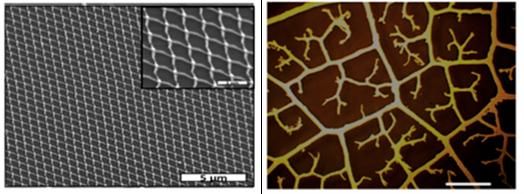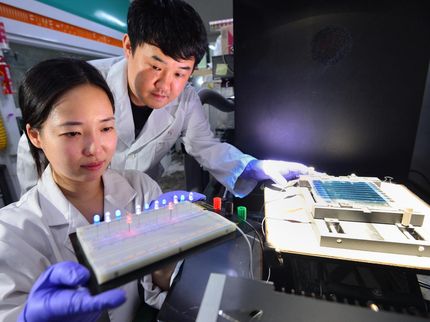Electrodes like leaf veins
Nanotechnology for energy materials
Nano-sized metallic wires are attracting increasing attention as conductive elements for manufacturing transparent electrodes, which are employed in solar cells and touch screen panels. In addition to high electric conductivity, excellent optical transmittance is one of the important parameters for an electrode in photovoltaic applications.

SEM – model of a metallic nano-network with periodic arrangement ( left) and visual representation of a fractal pattern (right).
M. Giersig/HZB
An international team headed by HZB scientist Prof. Michael Giersig has recently demonstrated for these applications that networks of metallic mesh possessing fractal-like nano-features surpass other metallic networks in utility.
Their new development is based on what is termed quasi-fractal nano-features. These structures have similarities to the hierarchical networks of veins in leaves. Giersig’s team was able to show that metallic networks with these features optimise performance of electrodes for several applications. They combine minimized surface coverage with ultra-low total resistance while maintaining uniform current density. In addition, it was demonstrated that these networks, inspired by nature, can surpass the performance of conventional indium tin oxide (ITO) layers. In experiments on artificially constructed electrode networks of different topologies, the scientists established that non-periodic hierarchical organisation exhibited lower resistance as well as excellent optical transmittance in comparison to periodic organisation. This led to elevated output power for photovoltaic components.
“On the basis of our studies, we were able to develop an economical transparent metal electrode", says Giersig, continuing “We obtain this by integrating two silver networks. One silver network is applied with a broad mesh spacing between the micron-diameter main conductors that serve as the “highway" for electrons transporting electrical current over macroscopic distances.” Next to it, additional randomly distributed nano-wire networks serve as local conductors to cover the surface between the large mesh elements. “These smaller networks act as regional roadways beside the highways to randomise the directions and strengths of the local currents, and also create refraction effects to improve transparency above that of classical shadow-limited performance”, according to Giersig. “Solar cells based upon these electrodes show exceptional a high efficiencies”.
Original publication
Bing Han, Qiang Peng, Ruopeng Li, Qikun Rong, Yang Ding, Eser Metin Akinoglu, Xueyuan Wu, Xin Wang, Xubing Lu, Qianming Wang, Guofu Zhou, Jun-Ming Liu, Zhifeng Ren, Michael Giersig, Andrzej Herczynski, Krzysztof Kempa & Jinwei Gao; "Optimization of hierarchical structure and nanoscale-enabled plasmonic refraction for window electrodes in photovoltaics"; Nature Comm.; 2016
Most read news
Original publication
Bing Han, Qiang Peng, Ruopeng Li, Qikun Rong, Yang Ding, Eser Metin Akinoglu, Xueyuan Wu, Xin Wang, Xubing Lu, Qianming Wang, Guofu Zhou, Jun-Ming Liu, Zhifeng Ren, Michael Giersig, Andrzej Herczynski, Krzysztof Kempa & Jinwei Gao; "Optimization of hierarchical structure and nanoscale-enabled plasmonic refraction for window electrodes in photovoltaics"; Nature Comm.; 2016
Topics
Organizations
Other news from the department science

Get the chemical industry in your inbox
By submitting this form you agree that LUMITOS AG will send you the newsletter(s) selected above by email. Your data will not be passed on to third parties. Your data will be stored and processed in accordance with our data protection regulations. LUMITOS may contact you by email for the purpose of advertising or market and opinion surveys. You can revoke your consent at any time without giving reasons to LUMITOS AG, Ernst-Augustin-Str. 2, 12489 Berlin, Germany or by e-mail at revoke@lumitos.com with effect for the future. In addition, each email contains a link to unsubscribe from the corresponding newsletter.



























































